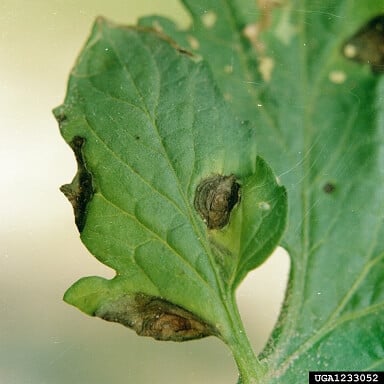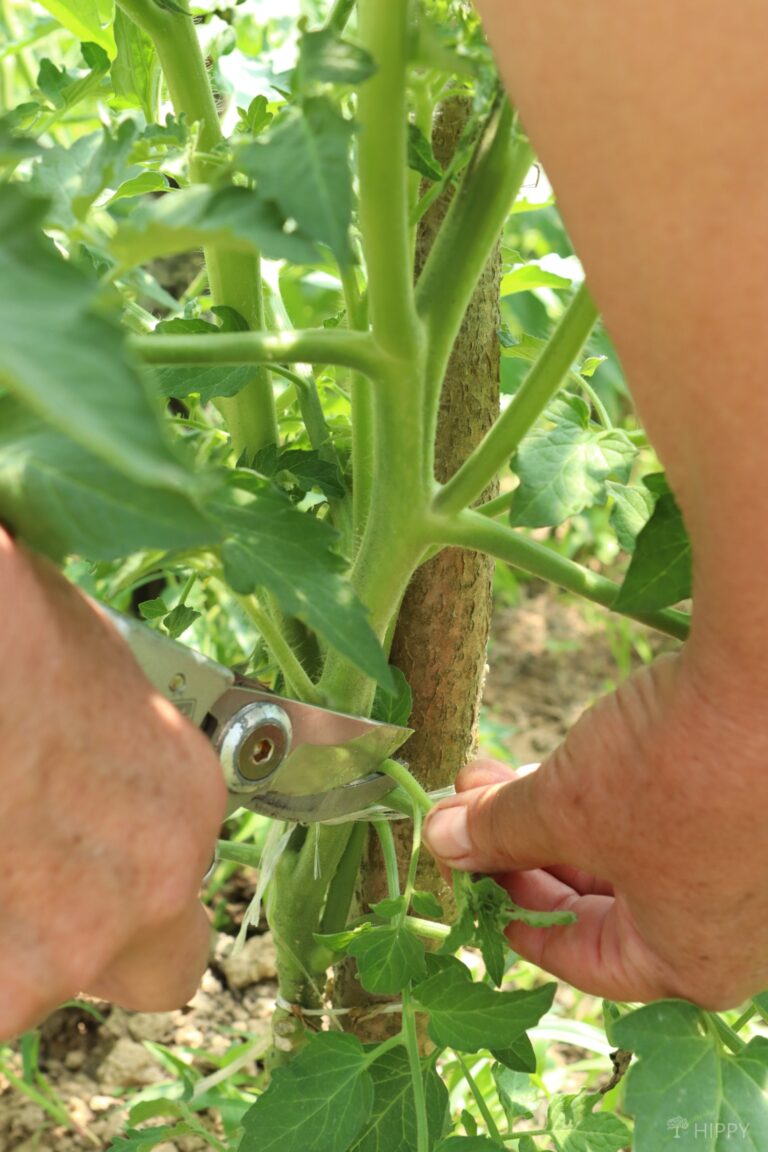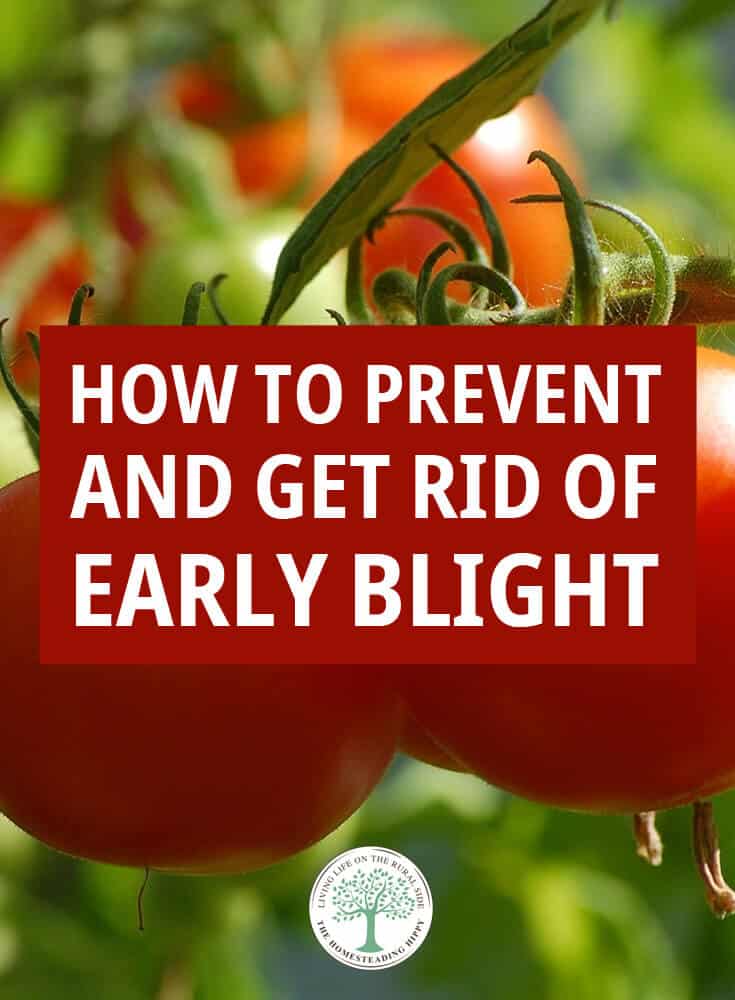You have worked hard to cultivate a gorgeous crop of tomatoes. From sunup to sundown, you’ve been out in your garden planting, watering, fertilizing, and pruning your plants, all in the hopes that your tomatoes will grow tall, verdant, and productive.
And then it hits – the early blight.
Blight is one of the most frustrating diseases that can affect your tomato plants, not only because it is so devastating, but because many gardeners think that there is little they can do to prevent it.
Think again. There are plenty of tips and tricks that you can put to good use to both prevent and get rid of early blight in your garden.

What is Early Blight?
Blight is a common fungal disease that practically every gardener has heard of. This disease attacks systematically, rapidly destroying the stems, leaves, and fruits of your tomato plants.
This disease spread by fungal spores. These spores are carried by the wind, water, insects, and animals, moving from infected plants before they are deposited on the soil or on new plants.
The spores require moisture in order to advance to the next stage, so when rain comes into contact with them, they will begin to rapidly reproduce.
Early blight is caused by the fungus Alternaria solani and causes a variety of symptoms. It can lead to secondary diseases like damping-off, crown rot, leaf blight, and fruit rot – and it can ultimately kill your plants. It thrives in humid, warm conditions.
There are several kinds of blight, including early blight, late blight, and Septoria leaf spot. These diseases are all remarkably similar, but generally affect your tomato plants at different times. Each can also affect different areas of the plant.
What are the Signs of Early Blight?
Early blight displays several telltale signs, with symptoms usually appearing after the first fruits appear on the tomato plants. Early blight will rear its head as small, brown lesions that look like bullseyes.
There will be dead plant matter in the center. The lesions will rapidly grow, with the surrounding plant tissue yellowing and then turning brown before the leaves die and fall off the plant altogether.
Early blight does not usually affect fruits directly, but indirectly, it can be devastating. Because the plant will have no more foliage to protect the fruits, the fruits are often damaged from direct sun exposure.
How Do I Treat Early Blight?
Unfortunately, there is no perfectly reliable cure for early blight. However, there are several ways it can be treated and prevented.
Only Purchase Healthy Plants
Even if you are getting a good deal on your tomato plants, never purchase those that seem to be sick or damaged. Only purchase healthy plants, and inspect any and all transplants carefully.
You should also plant varieties that are resistant to nematodes and wilt (indicated by a V, F, and N after the name of the specific cultivar). This will make it easier for your plant to withstand blight and other diseases.
Select Several Types of Plants – and Plant Them at Different Times
Choose a variety of plants that will mature at separate points. This will place your tomatoes at different stages of growth so that you don’t have to worry about an unfortunate case of blight wiping out your entire crop.
Early blight is more likely to affect early-maturing varieties of tomatoes, so consider planting in succession (or planting cultivars that mature at different times) so that you don’t have to worry about the timing of a blight.
Utilize Crop Rotation
Crop rotation can help prevent the passage of diseases in the soil. You should not plant potatoes or tomatoes next to each other, as they are both susceptible to blight.
In addition, you should plant your tomatoes in a different section of the garden each year to prevent the transmission of soilborne diseases. Don’t forget that these can linger throughout the winter months!
In addition to potatoes, you should also avoid planting your tomatoes in areas where eggplant or peppers have been grown within the last two years. These vegetables, also members of the Solanaceae family, can be carriers of blight, too.
Space Appropriately
Ensure adequate spacing between your plants. This isn’t only a good gardening practice in general, but it will also help reduce the likelihood of a bad blight spreading quickly among your plants. The further apart they are, the less likely they will contract early blight.
Practice Wise Watering
When you water your plants, only water at the bottom of the plant. Try not to get the leaves or stem wet, as this can increase the likelihood of blight. You should also water early in the day as opposed to in the middle of the day or evening.
Allowing moisture to remain on the plant for long periods of time not only increases the likelihood of blight, but it also makes it more likely that your plant will catch other fungal diseases as well.
When you water, consider using a soaker hose instead of an overhead sprinkler. This will reduce the likelihood that your leaves will become too wet, and it will also prevent soils pores from splashing back up onto the plants.
Prune Regularly
Keep an eye on the bottom branches of your tomato plants in particular. Make sure these branches don’t touch the soil, as this can increase the likelihood that they will become sick.
Prune tomatoes at least once throughout the growing season, removing the lower branches with a sterile, sharp pair of shears.

Trim right at the stem, but make sure you don’t cut into the stem. Open wounds can increase the risk of infection and also use up your plant’s valuable energy – which it could be putting toward growth – to heal itself.
Consider Mulching
Mulch is a fantastic resource in the garden, helping to keep the soil evenly moist and cool during the hottest months of the summer. It can also reduce your weeding chores and make it easier for you to maintain your garden.
Mulch to about two inches thick. This will reduce your watering needs and also prevent diseases besides blight, such as blossom end rot.
Stake Your Plants
Staking your plants can increase air movement through and around your tomato plants. This will reduce moisture on the foliage and improve the quality of your harvest. It can also prevent root rot, as your plants will be better supported as they continue to grow.
Staking helps keep your foliage upright and off the ground. Ideally, your foliage should be growing vertically and not pointing downward.
Clean Up Your Garden
We know you’re tired in the fall after a long season of gardening, but it’s imperative that you remove any and all plant debris after you have collected your harvest.
Tomato blight organisms can overwinter on dried plant matter, as can other harmful pests and diseases. Get rid of the plant matter to eliminate this risk.
While you’re at it, tossing a layer of organic compost onto the soil is a good habit to get into at the end of the season, too. The compost will prevent the likelihood of the spores splashing back up onto the plants when it rains.
Sanitize Your Equipment
You may not even think about it, but your garden tools need to be carefully sanitized between each season of use in order to ensure that they do not spread any disease. You can disinfect them with bleach and water after each use as a best practice, but at the very least, you should be cleaning them each season, too.
Consider Amending Your Soil For Next Year
If it’s too late to help this year’s crop from contracting early blight, consider some measures that you can take next year to prevent the likelihood of disease.
Infected tomatoes often can’t be saved, but you can easily prevent the problem from occurring in the future by solarizing the soil.
To do this, turn the soil in the planting area to a depth of six inches. Level and smooth it out. Dig a trench about six inches deep around the entire bed before soaking the soil (you can do this by running a sprinkler over it for a few hours).
Then, cover the bed with a layer of clear or black plastic. This will lock in heat and help kill any spores.
Regularly Inspect Your Crop
Keeping an eye on your tomato plants and checking them on a daily -or at the very least, weekly – basis can help you monitor any changes. This will make you aware of any potential pest or disease issues before they become full-blown problems.
If you notice signs of early blight or leaf spot on your plants, you should act quickly to remove or treat the problem. Blight can move quickly, so early detection is critical.
How to Get Rid of Early Blight
Early blight is definitely easier to prevent than it is to treat, but if you believe your tomatoes are infected with blight, don’t panic. There are several steps you can take to prevent the problem from getting worse.
Remove All Affected Leaves
Begin by removing all infected plants – or at the very least, prune back any affected leaves. You should burn them or place them in the garbage.
Do not compost them, as the heat from your compost will not be hot enough to kill the spores and they can spread to your future garden.
Next, you should carefully apply mulch around the base of the plant, especially if you haven’t already. This will help prevent spores from splashing onto the plant. You should use mulch that is ideally comprised of wood chips, straw, or another natural material.
Fungicidal Spray
You can use either a sulphur- or copper-based fungicidal spray to treat your tomato plants. Spray the plants’ leaves until they are soaked, ideally on a cloudy morning.
Do not use the fungicidal spray on hot, sunny days, as this can burn the leaves of the plant.
Some gardeners also recommend applying fungicides before any signs of disease appear.
This can help prevent early blight from appearing, particularly if you use a copper-based fungicide. You can also use a fungicidal spray whenever disease appears, as well as every seven to ten days as needed.
DIY Baking Soda Spray
If you prefer a more environmentally friendly method of getting rid of blight, you can use a homemade baking soda spray. These are ideal for killing fungi and won’t harm your plants. Baking soda sprays can also be used to fight late blight.
To make your own baking soda spray, simply combine a teaspoon of baking soda with a quart of warm water. You can also add a drop or two of liquid dish soap, which will help the solution adhere to the plant without damaging it in any way.
Pour this mixture into a spray bottle or watering can and mix it thoroughly. Then apply it to the plant. Do not apply this in direct sunlight, as it can burn your plant.
Remember that applying it too often (more than once or twice) can damage your plants as the baking soda is often too strong.
Compost Tea
Using compost tea on your tomato plants can be an effective way to fight early blight. You can easily make this by combining one-part well-aged compost (at least five months old) with six parts of water.
Place the mixture in a covered container and allow it to steep at temperatures between 60- and 70-degrees Fahrenheit. Stir it once a day.
On the fifth and last day of steeping, you should pour the mixture through a cheesecloth. The resulting liquid can be applied as a foliar spray.
Keep in mind, however, that you should not apply compost tea if you are planning to harvest in two or three weeks, as it can spread unwanted pathogens.
After reading this article, if you still aren’t sure how to identify and treat blight in your garden, make sure you check in with your local cooperative extension office.
They will be able to inform you as to whether blight has been found in your region, either on potato or tomato plants.
At the end of the day, knowing how to prevent and get rid of early blight is a skill that will serve you well as you continue to cultivate your garden.
Don’t let early blight steal your bountiful crop from you – take steps now so that your worries about blight are a thing of the past.
What other tips do you have for identifying, preventing, and treating early blight in the garden? Let us know in the comments!


Rebekah is a full-time homesteader. On her 22 acres, she raises chickens, sheep, and bees, not to mention she grows a wide variety of veggies. She has a huge greenhouse and does lots of DIY projects with her husband in her ever-growing homesteading endeavor. Learn more about Rebekah here.

Very informative, I’ll print and keep it handy I have 15 tomato plants, 4 different varieties.
Thank you